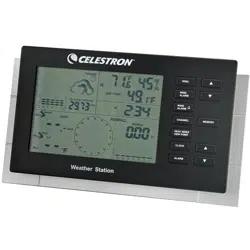Loading ...
Loading ...

3
Calibrating & Installing the Batteries of the Anemometer
After mounting the Anemometer, you need to calibrate the wind direction so that the Anemometer
properly measures the wind direction and transmits this information to the Receiver. Be sure the
batteries have been removed from the Anemometer before the calibration. You will have to
recalibrate the Anemometer whenever you replace the batteries.
Use the compass on the Anemometer and turn the wind vane so it is pointing due north (see drawing).
Hold the wind vane pointing due north and install the batteries. The red LED above the battery door
will flash a few times right after battery installation. Be sure the vane is pointing due north at the
moment when the red LED flashes and then the calibration is completed. Replace the battery door.
Press and hold the “CHANNEL/SEARCH” button a few seconds and the Channel 1 readings will
appear within 10 minutes if the wireless sensor transmission is successful.
Set Up the Power and Installation of the Rain Gauge
Choose a mounting location for the Rain Gauge that is a flat and level surface 164ft (50m) or closer in
an open area from the Receiver where data can be transmitted easily. The Rain Gauge should not be
blocked on the top or sides so that rain can freely reach the gauge (do not put under an overhang or
too close to a building or fence). Also, do not mount too close to the ground or to trees or plants.
To install the batteries in the Rain Gauge, turn it upside down (image below). Then, at the same time
push the two clips (inside of the two large holes at the ends) inward and lift off the cover and battery
compartment. Now turn the removed part upside down (image to the right) and pull out on the two
clips of the battery cover. Insert two AA batteries (user supplied) per the polarity markings on the
battery compartment. Then, replace the battery cover. Finally, replace the battery compartment and
cover into the outer housing by aligning with the clips and then pushing down on the cover over the
clips until they are secure.
Push and hold the “CHANNEL/SEARCH” button for a few seconds and the total rainfall will flash.
The total rainfall reading should appear within two minutes. If no display for total rainfall after two
minutes, then move the Rain Gauge closer and remove the batteries and repeat the above steps again.
Once the transmission to the Receiver is ok, then you are ready to
mount the Rain Gauge. Hold the base of the Rain Gauge flat
against the mounting surface and then use a level to make sure the
Rain Gauge is horizontally level. Use a pencil to trace the inside
of the mounting holes on the base of the Rain Gauge to mark the
screw locations. Drill a hole in the center of each marked screw
location and insert the supplied plastic screw plugs. Hold the Rain
Gauge against the mounting surface so the holes on the base are aligned with the plastic screw plugs
and then thread the supplied screws into each hole and use a screwdriver to tighten them.
Loading ...
Loading ...
Loading ...
